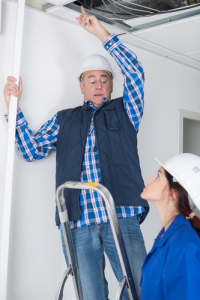Few electrical issues get such a bad rap as aluminum wiring. When properly installed (or with retrofitting to ensure safety), you have no real reason to be concerned about aluminum being used for your home wiring. At the same time, we understand the hesitation. Aluminum wiring just sounds cheap. Being inexpensive does not make inherently make it dangerous, though.
We’ve previously answered the question, “Is aluminum wiring really so bad?,” explaining that poor installation when aluminum was in vogue from the 1940s to 1970s have given it an undeserved bad reputation.
So, do you have to do something about aluminum wiring? Only in one of these situations:
- An electrical inspection has shown damage to wiring, the connectors, or switches.
- Your insurance company insists that you repair or replace old wiring.
- You’re selling your home to a buyer who insists on replacement.
In other words, you only need a clean bill of health from your local electrician to continue safely using that aluminum without any worries. If you do need to make changes, here are your options.
Conservative Approach: Aluminum Wiring Pigtailing & Repair
 Unless the wire itself has been damaged—which is possible because aluminum is less flexible than copper wiring—the real issue to look at is whether you have loose connections.
Unless the wire itself has been damaged—which is possible because aluminum is less flexible than copper wiring—the real issue to look at is whether you have loose connections.
Aluminum expands and contracts more than copper. If the builder or electricians in the past have used connectors made for copper, it’s possible that aluminum wires could have rusted and expanded to loosen the terminals a bit. That can literally send sparks flying, which is why old aluminum wiring might be dangerous.
So, the conservative approach to repairing aluminum wiring would be to replace all the connectors. An electrician can retrofit the home with copper-aluminum (CO-ALR) pigtail connectors, also marked Cu-Al or other abbreviations.
This can be an extensive project. Every outlet, switch, overhead light, junction box, and circuit breaker needs to be retrofitted. However, it’s much cheaper and less intrusive than the next option for fixing aluminum wiring.
Aggressive Approach: Replacing Aluminum Wiring
Again, we’d like to stress that you do not necessarily need to replace your home wiring. On the other hand, if you do have aluminum, it’s probably about 50 years old or older. You might just want to give in an replace aluminum wiring to appease a home buyer. And if your homeowner’s insurance is pushing for it, it might even be covered.
Replacing aluminum with copper wiring means we’ll have to put a few holes in the walls or ceilings, of course. An experienced electrician has replaced wiring countless times, though, so they should know how to do the job quickly and neatly.
Though a bit disruptive, you can consider it future-proofing your home against any fire hazards or damaged wiring that might result if you leave aluminum wiring in place.
Get Help Deciding What to Do About Aluminum Wiring
Before making any drastic decisions, you can start with a simple inspection by your local electrician. In Santa Rosa, contact Spyrka Electric to get the opinion of a licensed electrician and breathe easy—repairing or replacing aluminum wiring may not be as big a deal as you think!

